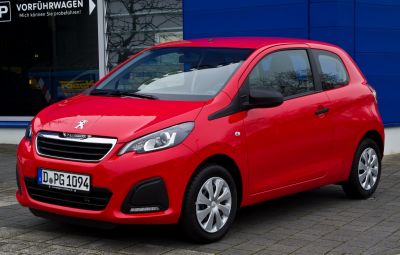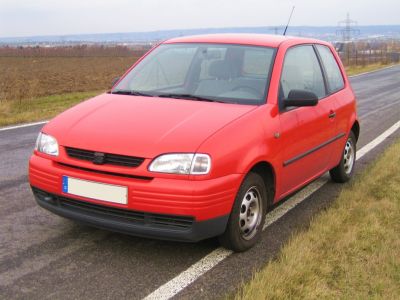 1988 Mazda 121 I (DA) Dimensions, Size & Specs
1988 Mazda 121 I (DA) Dimensions, Size & SpecsMeasurements of the 1988 Mazda 121 I, engineered for optimal performance and comfort
| Dimensions | |
|---|---|
| Length: | 3475 mm136.8 in11.4 ft |
| Width: | 1605 mm63.2 in5.3 ft |
| Height: | 1450 mm57.1 in4.8 ft |
| Weight Specifications | |
| Curb Weight: | 725-755 kg1598-1664 lbs |
The Mazda 121 I (DA), produced between 1988 and 1991, is a compact hatchback that stands out for its efficient design, ideal for urban driving and maneuverability in tight spaces. This first generation model features a length of 3475 mm (approximately 137 inches), a width of 1605 mm (about 63.2 inches), and a height of 1450 mm (around 57.1 inches), making it a small and agile vehicle. Weighing between 725 and 755 kilograms (1598 to 1664 pounds), the Mazda 121 I (DA) offers a lightweight build that enhances fuel efficiency and responsive handling. As a hatchback, it combines practicality with economy, providing enough interior space for daily needs while maintaining a reduced footprint that benefits parking and navigating busy city streets. Its size and weight category place it firmly in the subcompact segment, well-suited for drivers seeking a reliable and easy-to-park vehicle from the late 1980s to early 1990s. The Mazda 121 I (DA) remains a notable example of Japanese automotive design during this period, emphasizing minimalism and function in a stylish compact package.
Discover the standout features that make the 1988 Mazda 121 I a leader in its class
Have a question? Please check our knowledgebase first.
The Mazda 121 I (DA) hatchback, produced from 1988 to 1991, has a compact profile ideal for city driving and urban environments. Its length measures 3475 mm (136.9 inches), making it relatively short which contributes to its maneuverability. The width is 1605 mm (63.2 inches), providing a reasonably wide stance for stability while remaining slim enough for easy navigation through narrow streets or crowded parking lots. The height stands at 1450 mm (57.1 inches), giving enough headroom inside without making the car too tall or bulky. These dimensions collectively make the Mazda 121 I (DA) a practical choice for drivers who prioritize ease of parking, fuel efficiency, and urban agility.
The curb weight of the Mazda 121 I (DA) ranges between 725 kg to 755 kg (approximately 1598 to 1664 pounds). This lightweight design contributes positively to the car’s performance, particularly in terms of agility and acceleration with smaller displacement engines typical of this model. The lower mass also means better fuel efficiency, as the engine requires less power to move the vehicle compared to heavier cars. This makes the Mazda 121 economical for daily commuting and city driving, as it balances good fuel economy with nimble handling characteristics.
Yes, the Mazda 121 I (DA) hatchback fits comfortably into a standard residential garage. With a length of 3475 mm (136.9 inches) and width of 1605 mm (63.2 inches), it occupies less space compared to many modern vehicles, making it easier to park in typical home garages that generally accommodate lengths of around 5 to 6 meters (196.9 to 236.2 inches) and widths of about 2.5 to 3 meters (98.4 to 118.1 inches). The car's relatively low height of 1450 mm (57.1 inches) also ensures there are no vertical clearance issues. This compact footprint makes the 121 I (DA) very practical for owners with standard garage dimensions.
The Mazda 121 I (DA) offers a modest yet efficient interior space consistent with many subcompact hatchbacks from the late 1980s and early 1990s. While specific interior dimensions such as legroom and headroom are not detailed here, its external dimensions suggest it was designed primarily for practicality over luxury, emphasizing sufficient passenger accommodation rather than expansive space. Despite its compact size (3475 mm length), the hatchback format typically allowed for versatile cargo options with rear seats that could fold down for extra boot capacity, catering well to urban users seeking functional daily drivers with decent storage flexibility.
The Mazda 121 I (DA) was introduced as an update to the earlier 121 models, continuing Mazda's approach towards compact and efficient urban cars. While exact predecessor model dimensions vary, the I (DA) generation maintains a similarly compact size, with a length of 3475 mm (136.9 inches), width of 1605 mm (63.2 inches), and height of 1450 mm (57.1 inches), along with a curb weight range of 725-755 kg (1598-1664 pounds). The focus was on optimizing space and weight to improve fuel economy and driveability, making it lighter or comparable in weight to its predecessor. Incremental enhancements in design and materials likely contributed to marginal weight reductions and dimension refinements for better aerodynamics and practicality.
When compared with similar hatchbacks from the late 1980s to early 1990s era—such as the Volkswagen Polo Mk2, Ford Fiesta Mk3, and Toyota Starlet—the Mazda 121 I (DA) is fairly typical in size and weight. Its length of 3475 mm (136.9 in) is slightly on the shorter side, making it an especially nimble option in urban settings. Its width of 1605 mm (63.2 in) aligns well within the subcompact category norm, balancing interior space and exterior compactness. The weight range of 725 to 755 kg (1598 to 1664 lbs) ensures it remains light-weight compared to some competitors. Overall, the Mazda 121 I (DA) offered competitive dimensions suitable for city driving and efficient daily use in its class.
The precise ground clearance of the Mazda 121 I (DA) hatchback isn't specified in the data provided, but typically, small hatchbacks of this period have ground clearances ranging between 140-160 mm (5.5-6.3 inches). Assuming the Mazda 121 falls within this range, it would provide adequate clearance for typical urban conditions, such as speed bumps and uneven pavements. However, it may be less suitable for rough rural roads or off-road conditions where higher clearance is necessary. The balanced clearance ensures a low center of gravity aiding stable handling while allowing enough buffer to avoid scraping under moderate road obstacles.
The Mazda 121 I (DA) was designed primarily as a compact, economical city car. During its production period (1988-1991), it typically featured small-displacement four-cylinder gasoline engines, favored for their balance of power and fuel economy. Specific engine sizes often ranged from 1.1 to 1.3 liters, with fuel efficiency around 6 to 7 liters per 100 kilometers (approximately 40-47 mpg US), depending on driving conditions and engine specification. These efficient powertrains made the 121 I (DA) an affordable choice with low running costs, aligning well with the expectations of urban commuters and entry-level buyers.
The Mazda 121 I (DA), being a hatchback, prioritizes flexibility within its compact design. It typically seats four occupants comfortably, with two front seats and a rear bench suitable for two adults or three smaller passengers depending on space optimization. The hatchback configuration offers practical cargo space that can be expanded by folding the rear seats down, enabling transport of larger items despite the vehicle's compact exterior dimensions (3475 mm length). This adaptability makes the car suitable for daily errands and light cargo transport needs typical for small urban vehicles.
During its production from 1988 to 1991, the Mazda 121 I (DA) gained popularity due to its compact size, economical fuel consumption, and ease of driving in city settings. Mazda's reputation for durability and engineering contributed to its reliability, making it a sensible choice for budget-conscious drivers. Although not as widely recognized as some competitors in certain markets, it nonetheless earned respect for its straightforward mechanics, low maintenance costs, and practical design. The 121 I (DA) served well as an entry-level hatchback for those looking for dependable transport with affordable running costs.
Discover similar sized cars.

| Production: | 2018-present |
|---|---|
| Model Year: | 2018 |
| Length: | 3475 mm136.8 in |
| Width: | 1884 mm74.2 in |
| Height: | 1460 mm57.5 in |

| Production: | 2014-present |
|---|---|
| Model Year: | 2014 |
| Length: | 3475 mm136.8 in |
| Width: | 1884 mm74.2 in |
| Height: | 1460 mm57.5 in |

| Model Year: | 2016 |
|---|---|
| Length: | 3546-3667 mm139.6-144.4 in |
| Width: | 1866-1893 mm73.5-74.5 in |
| Height: | 1488-1519 mm58.6-59.8 in |

| Production: | 2010-2015 |
|---|---|
| Model Year: | 2007 |
| Length: | 3546 mm139.6 in |
| Width: | 1627 mm64.1 in |
| Height: | 1488 mm58.6 in |

| Production: | 2013-2016 |
|---|---|
| Model Year: | 2013 |
| Length: | 3540 mm139.4 in |
| Width: | 1910 mm75.2 in |
| Height: | 1498 mm59.0 in |

| Production: | 2013-2016 |
|---|---|
| Model Year: | 2013 |
| Length: | 3563 mm140.3 in |
| Width: | 1649 mm64.9 in |
| Height: | 1516 mm59.7 in |

| Production: | 2011-2016 |
|---|---|
| Model Year: | 2012 |
| Length: | 3540 mm139.4 in |
| Width: | 1645 mm64.8 in |
| Height: | 1489 mm58.6 in |

| Production: | 1997-2000 |
|---|---|
| Model Year: | 1997 |
| Length: | 3536 mm139.2 in |
| Width: | 1639 mm64.5 in |
| Height: | 1480 mm58.3 in |
